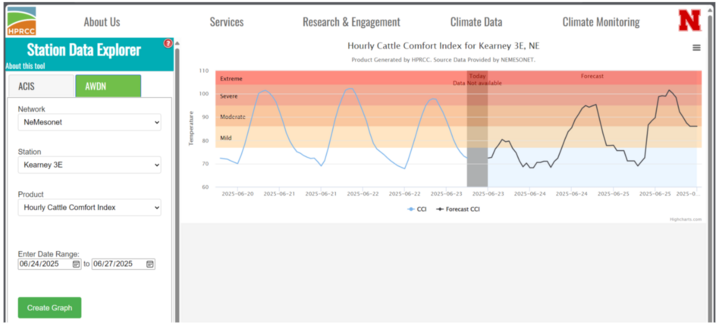As temperatures rise, so does the risk of heat stress for feedlot cattle—affecting everything from health to performance and profitability. The Temperature Humidity Index (THI) provided producers with a guide to managing heat risk.
But now, the Cattle Comfort Index (CCI) is available for current conditions in a statewide map on the Nebraska Mesonet with sidebar access to each weather station (Figure 1) or as current and forecast conditions on the High Plains Regional Climate Center website (HPRCC; ) for each weather station (Figure 2).
These tools are available through a collaboration between Nebraska Mesonet and HPRCC. The CCI was developed by Dr. Terry Mader, University of Nebraska-Lincoln Animal Science Emeritus Professor, and collaborators while at the Haskell Agricultural Laboratory in Concord, Nebraska.
The Cattle Comfort Index (CCI) includes:
- Wind speed
- Solar radiation (sun exposure)
- Air temperature
- Humidity
Together, these factors offer a more accurate picture of what cattle experience—not just what the thermometer and hygrometer say.
Why move beyond THI?
While THI offers a basic snapshot of heat risk by combining temperature and humidity, it overlooks several critical environmental factors that affect cattle comfort and heat load.
These variables combine to better reflect the actual conditions cattle experience, including the effects of both heat and cold stress. For example, at the same temperature and humidity, a hot, breezy day with cloud cover poses lower risk than a hot, still, sunny day—CCI captures that difference, while THI does not.


How to start using CCI
The current CCI is available as a statewide map or for each station.
- Navigate to the Nebraska Mesonet website.
- Preview the CCI map (Figure 1).
- For additional station-specific information, select the station on the right-side ribbon (Figure 3).

The current and forecast CCI are already integrated into the HPRCC website:

- Navigate to the HPRCC website: https://hprcc.unl.edu/stationtool/explore.php#
- Select the AWDN tab (Figure 4)
- Select Network: NeMesonet
- Select Station/Location
- Select Hourly Cattle Comfort Index
- Enter Date Range
Why CCI matters for your operation
Think of CCI as your early warning system specifically for livestock.
- Spot heat events sooner
- Make proactive decisions—adjust feeding, water access, or shade
- Reduce performance losses and death loss
- Provide animal comfort and enhance stress recovery
Understanding and using CCI
When Dr. Mader and collaborators developed the CCI they used data from previous years on effects of weather events on cattle performance. Heat stress in animals results from the cumulative effects of the factors modeled by the index and the capacity of each animal to respond to these.
Using performance data and their observations, Dr. Mader and collaborators developed a set of CCI thresholds for heat stress. They emphasized that these thresholds are arbitrary and may be shifted based on age, adaptation to thermal stress, insulation and fat content, size, shape and feed intake. The original thresholds proposed by them are provided as guidelines in Table 1.

As users become familiar with CCI, they will understand how to respond to current or forecast conditions using this table as a guideline. In Table 1, the bottom reading for the mild heat stress category is 77 and corresponds with morning CCI readings prevalent during all heat events, also characterized by little or no night cooling, considered by Dr. Mader and collaborators in the development of CCI.
Nights with mild to no heat stress, characterized by CCI readings below 77 are required to permit cattle relief from daytime heat stressors. When reading CCI in the forecast (https://hprcc.unl.edu/stationtool/explore.php#), the user is advised to glide the computer pointing device over the CCI line on the graph to determine whether CCI readings will reach and/or fall below 77 during the night. Forecast CCI above this reading should serve as a trigger to deploy heat abatement strategies.
Similarly, heat load in cattle results from the accumulation of days with CCI above the high-end threshold for mild heat stress (86). The accumulation of days with CCI readings above 86, particularly with few or no nights under CCI of 77, should also serve as triggers to deploy heat abatement strategies.
As temperatures rise, so does the risk of heat stress for feedlot cattle, which CCI can be an early warning system for livestock.

